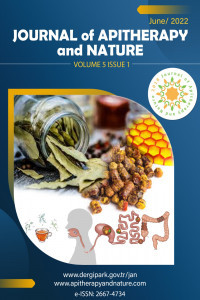Preliminary Evaluation of the Cytotoxic Potential of North-West Romanian Propolis
Preliminary Evaluation of the Cytotoxic Potential of North-West Romanian Propolis
Cytotoxic Potential, North-West Romanian Propolis,
___
- 1. Dantas Silva RP, Machado BA, Barreto GA, Costa SS, Andrade LN, Amaral RG, Carvalho AA, Padilha FF, Barbosa JD, Umsza-Guez MA (2017) Antioxidant, antimicrobial, antiparasitic, and cytotoxic properties of various Brazilian propolis extracts. PLoS One 12(3): e0172585.
- 2. Campos JF, dos Santos UP, Macorini LF, de Melo AM, Balestieri JB, Paredes-Gamero EJ, Cardoso CA, de Picoli Souza K, dos Santos EL (2014) Antimicrobial, antioxidant and cytotoxic activities of propolis from Melipona orbignyi (Hymenoptera, Apidae).Food Chem Toxicol.65: 374-80.
- 3.Niculae M, Stan L, Pall E, Paștiu AI, Balaci IM, Muste S, Spînu M (2015) In vitro synergistic antimicrobial activity of Romanian propolis and antibiotics against Escherichia coli isolated from bovine mastitis. Notulae Botanicae, Horti Agrobotanici. 43(2): 327-334.
- Yayın Aralığı: Yılda 2 Sayı
- Başlangıç: 2018
- Yayıncı: Oktay YILDIZ
Propolis: A Natural Product – Great Potential as a Medicine
ARC (Apiceutical Research Centre): Developing a Global BeePharma Network Local Help for Local Health
Quantitative and Qualitative Variations in Propolis Collection
C. TANANAKI, A. THRASYVOULOU, D. KANELIS, V. LIOLIOS
Chemical Composition of Selected Propolis Samples from Kyrgyzstan and Kazakhstan
Argyro PETROPOULOU, Konstantia GRAIKOU, Jaroslaw WIDELSKI, Krystyna SKALICKA-WOŹNIAK, Zuriyadda SAKIPOVA, İoanna CHINOU
Preliminary Evaluation of the Cytotoxic Potential of North-West Romanian Propolis
Constantin İ. MATES, Emoke PALL, Marina SPINU, Laura STAN, Mihaela NICULAE
Shankar KATEKHAYE, Hugo FEARNLEY, James FEARNLEY, Anant PARADKAR
The Effects of Propolis on Growth Performance of Broiler Chickens
İvana KLARIC, Matija DOMACINOVIC, Berislav PRAKATUR, İvan MISKULIN, Bozica LACHNER, Dalida GALOVIC, Danijela SAMAC
The Biological Activities of Indonesian Propolis and It’ s Molecular Marker
Muhamad SAHLAN, Diah Kartika PRATAMI, Safira Candra ASIH, Andrea DEVINA, Alfiani Guntari MAHADEWI, Masafumi YOHDA, Siti FARIDA, Robiatul ADAWIYAH, Herbert SITUMORANG, Heri HERMANSYAH, Anondho WIJANARKO
The Immune Modulatory and Anti-protozoal Effects of Different Propolis Samples
David G. WATSON, Harry de KONING, Godwin EBILOMA, John IgoLI, Weam SIHERI, Naif ALENZI, Samyah ALANAZI, Sameah ALENEZI, William HARNETT
Zaccaria VINCENZO, Galeotti FABIO, Fachini ALFREDO, Passarella PAOLO, Daglia MARIA, Volpi NICOLA
